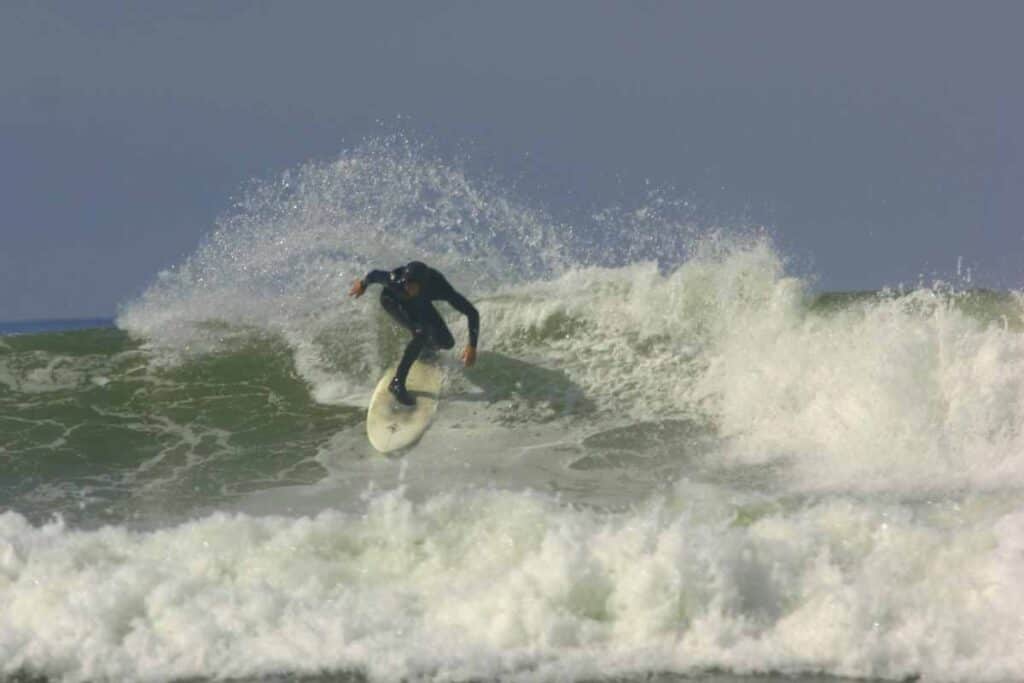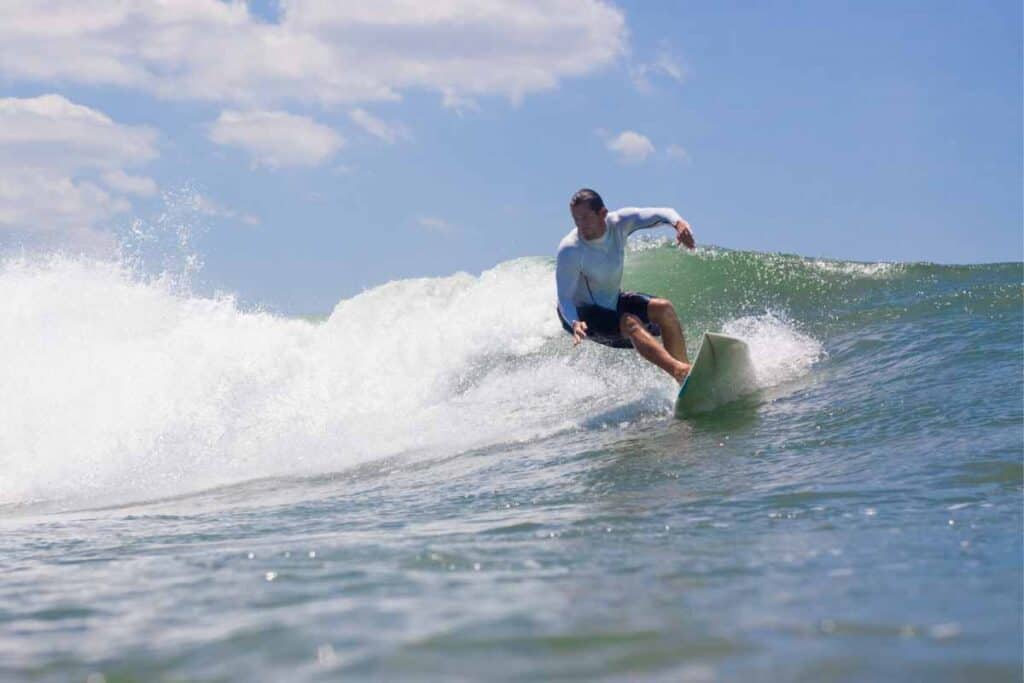Learning how to do a cutback is a fundamental skill for any surfer.
This maneuver involves shifting your weight from your toeside to your heelside using your back foot, using your front foot to control the board’s transition from rail to rail without losing speed, and looking over your shoulder to make sure you don’t bury the nose of the board.

The more power you apply on your carving rail, the more spray you’ll get.
Whether you’re a beginner or an intermediate surfer, mastering the cutback will help you navigate the wave and generate speed. It’s a versatile move that can be used in a variety of conditions, from small, mushy waves to overhead barrels. In this article, we’ll take a closer look at the cutback and provide you with some tips and techniques to help you improve your skills.
Before we dive into the details, it’s important to note that learning how to do a cutback takes time and practice. Don’t get discouraged if you don’t get it right away – keep at it and you’ll eventually get the hang of it.
With that said, let’s get started!
Understanding the Cutback
The cutback is a fundamental surfing maneuver that involves turning the surfboard back towards the breaking wave.

It is a crucial part of a surfer’s repertoire and can be used to generate speed, stay in the power zone, and set up for the next maneuver.
A well-executed cutback can be a beautiful sight to behold and can make the difference between a good and a great wave ride.
When performing a cutback:
- The surfer needs to shift their weight from the toe-side rail to the heel-side rail, rotate their hips, and open their leading arm and head around as they extend their body into the turn. The surfer should use light pressure on their front foot and turn their head over their outside shoulder. The leading arm should guide the surfer and control the extent of the cutback.
- Body positioning is crucial in executing a successful cutback. The surfer should place their back foot on the tail of the board and the front foot towards the center of the board. This helps the surfer maintain control and generate speed as they approach the turn. The surfer should also keep their eyes on the part of the wave where they want to cut back and use their front foot to control the board’s transition from rail to rail without losing speed.
It is important to note that the cutback is not just about turning the surfboard back towards the wave. It is also about maintaining speed and flow throughout the maneuver.
The surfer should aim to complete the cutback smoothly and efficiently, without losing momentum or speed. With practice and patience, surfers can master the cutback and add it to their arsenal of surfing maneuvers.
Choosing the Right Wave

Choosing the right wave is crucial for a successful cutback.
Here are some tips to help you pick the perfect wave:
- Look for a wave that is diagonal, not vertical or horizontal. Cutting back on a vertical wave can lead to a wipeout, while cutting back on a horizontal wave can cause you to lose speed and the wave.
- Find a wave that is peeling, not closing out. A peeling wave will allow you to ride it for a longer period of time, giving you more opportunities to perform a cutback.
- Consider the size of the wave. A smaller wave may be easier to navigate and perform a cutback on, while a larger wave may provide a more thrilling experience.
- Observe the wave’s break. Waves that break consistently in the same spot are more predictable and easier to ride, giving you a better chance to execute a cutback.
Remember, choosing the right wave is just as important as executing the cutback itself. Take your time to find the perfect wave and you’ll be rewarded with a successful maneuver.
Setting Up for the Cutback

Before executing a cutback, it’s important to set yourself up for success.
Here are a few tips to help you get ready for the maneuver:
- Position yourself on the wave face so that you’re coming down the line at full speed on a diagonal angle.
- Place your back foot on the tail of the board and your front foot towards the center of the board to maintain control and generate speed as you approach the turn.
- Transfer your weight from your toe-side rail to your heel-side rail as you begin to initiate the cutback.
Body positioning is also crucial in executing a successful cutback.
Here are a few things to keep in mind:
- Rotate your hips and open your leading arm as you extend your body into the turn.
- Turn your head over your outside shoulder to guide your movement and control the extent of your cutback.
- Keep light pressure on your front foot to maintain control and balance throughout the maneuver.
Remember, a cutback is more than just turning back towards the whitewater. It’s a beautiful maneuver that requires skill, speed, and control.
By setting yourself up properly and focusing on your body positioning, you’ll be able to execute a successful cutback and add a stylish element to your surfing.
Executing the Cutback
Executing a cutback requires proper foot placement and body positioning.
Here are the steps to execute a cutback:
- Approach the turn at full speed on a diagonal wave face.
- Place your back foot on the tail of the board and your front foot towards the center of the board to maintain control and generate speed.
- Transfer your weight from your toe-side rail to your heel-side rail.
- Rotate your hips, open your leading arm, and head around as you extend your body into the turn.
- Light pressure on your front foot and turn your head over your outside shoulder.
- Allow your leading arm to guide you and control the extent of your cutback.
It’s important to note that a cutback is more than just turning back towards the whitewater. Your body positioning and weight distribution play a crucial role in executing a successful cutback.
Keep practicing and refining your technique to master this important surfing maneuver.
Common Mistakes to Avoid
While the cutback maneuver may seem simple, many surfers make some common mistakes that can ruin the maneuver.

Here are a few things to avoid:
- Don’t cut back too late: Cutting back too late can cause you to lose speed and miss the curl of the wave. Make sure to initiate the maneuver at the right time.
- Don’t cut back too hard: Cutting back too hard can cause you to lose control and wipe out. Make sure to control the extent of your cutback and maintain your balance.
- Don’t look down: Looking down can cause you to lose your balance and miss the curl of the wave. Keep your head up and look towards the direction of your turn.
- Don’t forget to transfer your weight: Transferring your weight from your toe-side rail to your heel-side rail is crucial for initiating the cutback. Make sure to do this smoothly and efficiently.
By avoiding these common mistakes, you can ensure that your cutback maneuver is smooth, stylish, and successful. Remember to practice and master the basic techniques before attempting more advanced maneuvers.
Last words
Learning how to do a cutback in surfing can take time and practice, but it is a crucial skill to master if you want to take your surfing to the next level. By generating enough speed on your takeoff, eyeing your path towards the shoulder of the wave, and initiating a shallow bottom turn, you can set yourself up to execute a clean, well-timed cutback.
Remember to focus on your body positioning, keeping your weight centered over your board, and using your back foot to pivot and redirect your momentum back towards the wave. It’s important to stay relaxed and fluid in your movements, allowing yourself to flow naturally with the wave.
As you continue to practice, you may find it helpful to break the cutback down into phases and focus on one aspect at a time, such as the bottom turn or the redirection of momentum. And don’t forget to have fun and enjoy the ride!
